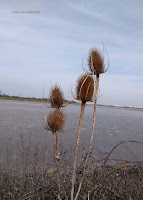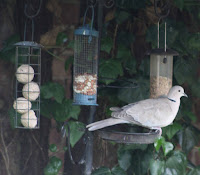How Can We Encourage More Birds Into Our Gardens?
There is nothing quite like the quiet joy of watching birds
in your own garden. The RSPB Big Bird Watch
results for 2018 show that smaller birds are increasing in numbers in our
gardens. Goldfinches are up 11% on
2017’s numbers, and greenfinches are up 5% which is really pleasing. Long-tailed tits and coal tits are also
increasingly seen. But perennial
favourites robins and blackbirds had lower numbers reported this year. So how can we encourage more birds into our
gardens?
Your Garden as an
Ecosystem
You will get an increase of visitors with a well supplied table
or feeder, but to make a garden more inviting to birds year round a long term
approach is needed. Our human idea of a
beautifully manicured formal garden with decking and a wooden fence all round
is sadly unattractive to wildlife. But
most of us need our gardens to be family and pet friendly spaces where we
entertain and enjoy our summer. Happily
there can be a compromise.
 |
| Starlings love chafer grubs! |
If you can, perhaps consider gardening without
pesticide. Your garden really is a tiny
ecosystem on a very delicate balance. Things
that we consider pests – slugs and snails, aphids, caterpillars and grubs- are
all food for someone. Similarly,
forgetting the traditional autumn garden clear up can help our birds. Lots of plants have seed heads that finches
and sparrows will greedily come down for.
The remaining plant material gives invertebrates a place to shelter, and
these invertebrates are food for wrens, goldcrests and dunnocks. I didn’t clear the old sweetcorn plants from
my garden last year, and wrens came most days to pick around the plants. Up til now I’d never seen a wren in the
garden, so I’ll definitely do it again!
I’ve also had a friendly blackbird rummaging for grubs in the bark chippings.
What Garden Plants
Will Help Birds?
A thoughtful planting plan will provide food and shelter for
both residents and seasonal visitors.
Ivy. Now
don’t get me wrong, I know ivy can be a pain in the garden. It starts off small and cute, you turn your
back and it becomes a raging garden claiming oaf. And it’s flowers smell
terrible. So why am I telling you it’s
great? Ivy gives so much to the birds.
Its flowers are so attractive to pollinators. Ivy berries are a vital food source for many
birds as varied as blackbirds and pigeons through the winter. It’s a dense plant which gives birds shelter
from predators and a nest site for thrushes, blackbirds and robins.
Pyracanthia. This might not be a great garden addition if
you have small children as it’s a thorny beast.
Birds love its berries, you can expect to see blackbirds, robins, thrushes,
even passing fieldfare and redwing in winter. Its quite a densely growing plant
which gives smaller birds added protection and shelter. Holly berries provide similar birds a meal in winter.
 |
| Teasel will attract goldfinches |
Fruit trees. If
you have fruit trees try leaving a few gnarly apples or pears on the tree or as
windfalls for the winter. Redwing and
fieldfare enjoy fruit and you may even be lucky enough to get a hungry
waxwing. Of course, if you have cherries
or soft fruit, they won’t wait for your invitation, they’ll happily help
themselves.
Can I Persuade Birds
To Nest In My Garden?
Certainly, if you give them appropriate nesting sites. Wrens
and long-tailed tits like a thick, dense hedge.
Most other tits nest in holes in trees which makes them the perfect
candidate for your nesting box. Don’t go
for too garish a coloured box though, however lovely you think it looks birds
know predators will easily see it and will be put off. Chaffinches, greenfinches and goldfinches
nest in trees between branches. Leave
nesting material around for them. After
I comb the Official Blog Dog, I leave the fur in a rose bush for the birds to
collect. They will also collect twigs
and moss, long-tailed tits even look for spider web. So leaving your garden a little less
manicured will do your feathered friends a favour.
Birds are creatures of habit and routine so don’t expect a
chirping noisy flock to greet you immediately.
With a little patience and forethought, you can encourage the birds into
your garden for years to come.



Comments
Post a Comment